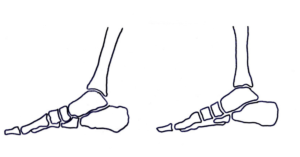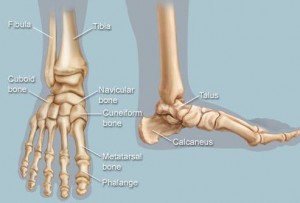 Foot and Ankle Bones: The Tibia and The Talus
Foot and Ankle Bones: The Tibia and The Talus
The foot and ankle bones, tibia, and talus connect the lower leg to the foot.
The feet are flexible structures of bones, joints, muscles, ligaments, and tendons. They let us stand upright and perform activities like walking, running, and jumping.
Their alignment determines in large part how everything is able to stack on top of them.
The feet are our base and if we don’t start the journey of skeletal support at the bottom it is not likely that we will have a happy top.
There are three arches in each foot. If balanced with the proper muscle and ligamentous tone, they create a perfect stand upon which to rest.
In the foot and ankle bones, the talus rests below the tibia. Their connection sets the tone for everything above and below.
People with less than optimal foot arches are often searching for a fix either through alignment cues, orthotics, or arch supports.
Orthotics are designed to support feet that fail to support the body successfully and they do work.
But they aren’t meant to be a long-term solution. If you use them for a prescribed period of time, develop an arch, and then do away with the orthotic, they are great.
One way to see your arches at work is to lift your toes. When the toes are up you can also get a sense of the arch and what kind of action it has.
Lifting the toes to support the lift of the arches is a fine thing to do as an exercise as well.
It can be used to build muscle tone and encourage a realigning of the foot and ankle bones.
But walking around or doing yoga with toes lifted so not a lifestyle change anyone needs to implement full time.
Build muscle to change alignment.
 And unfortunately, I have seen people who have lifted their toes for so long, they forgot that they don’t need to be lifted.
And unfortunately, I have seen people who have lifted their toes for so long, they forgot that they don’t need to be lifted.
The alignment of these foot and ankle bones, the tibia and talus, should be the starting point of all footwork.
The foot and shin ideally form a right angle. This stacks the tibia directly about the talus.
If you can do this you can see what your feet actually do.
What this means is you might see a very flat foot collapsing to the floor. Accept it if that is who you are today.
This post stemmed from a conversation I had with someone who had been told to lift a particular bone in their foot by an endless assortment of teachers.
In this instance lifting this bone (the navicular) pulled this person’s feet to the outside and threw off the relationship between the tibia and the talus which is an unacceptable fix.
This is a classic can’t see the forest for the trees situation, which unfortunately occurs endlessly in our search for good posture.
Visual aesthetics often trump correct alignment.
If we align the tibia and the talus correctly and then the navicular bone appears to be collapsed, so be it.
The answer will be to find a solution for building the muscles that will lift and support the navicular.
This is better than throwing off the foot-ankle complex to accommodate one bone.
Take a good look at your foot and ankle bones, trying to line up the tibia and the talus correctly.
Once you get these two important bones lined up well, you can then assess what you need to work in your foot to bring the rest of the bones up to speed.
***

